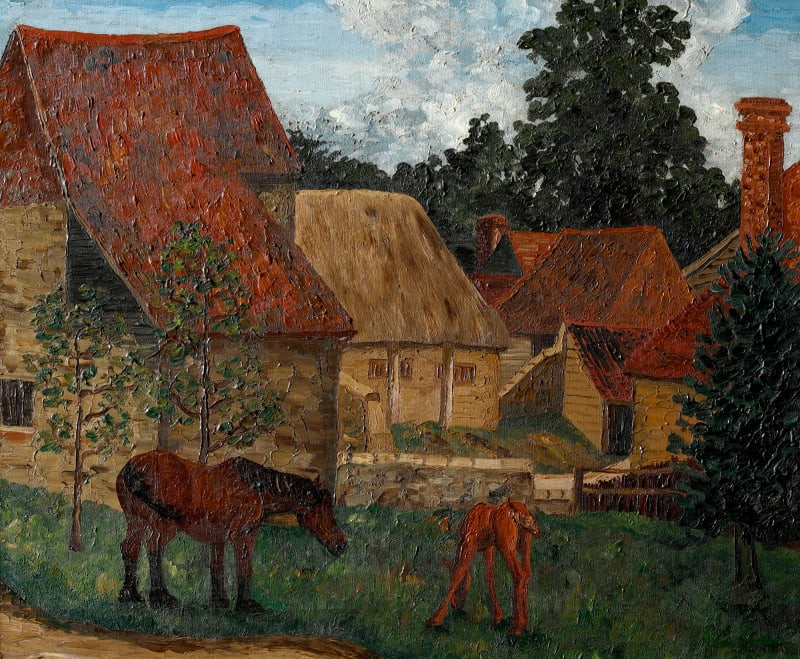This striking and important work was painted by Cedric Morris in 1935 and depicts his favourite subject, Irises. Painted in bold, saturated colours, Morris presents his subject in a highly original and distinctive manner, and when it was exhibited in 1935 it was described by one critic as one of his most successful flower pieces.[1]
After living in Cornwall (1919-1920) and Paris (1920-1925) Morris and partner Arthur Lett-Haines (known as Lett) moved to London. By this date London was an international artistic epicentre and Morris soon solidified his reputation as one of the leading artists of the day. Although experiencing meteoric success with sell-out exhibitions and endless commissions, Morris began to tire of city life and in particular disliked the way dealers would edit his artistic output ‘to eliminate the more unusual and technically interesting paintings which go to make a genuine reputation as opposed to that of a “best seller”. Yearning for artist freedom, in early 1929 Morris and...
This striking and important work was painted by Cedric Morris in 1935 and depicts his favourite subject, Irises. Painted in bold, saturated colours, Morris presents his subject in a highly original and distinctive manner, and when it was exhibited in 1935 it was described by one critic as one of his most successful flower pieces.[1]
After living in Cornwall (1919-1920) and Paris (1920-1925) Morris and partner Arthur Lett-Haines (known as Lett) moved to London. By this date London was an international artistic epicentre and Morris soon solidified his reputation as one of the leading artists of the day. Although experiencing meteoric success with sell-out exhibitions and endless commissions, Morris began to tire of city life and in particular disliked the way dealers would edit his artistic output ‘to eliminate the more unusual and technically interesting paintings which go to make a genuine reputation as opposed to that of a “best seller”. Yearning for artist freedom, in early 1929 Morris and Lett took the lease of The Pound, near Higham in Suffolk.
Within the popular narrative of Morris’s life and work, The Pound is often overlooked in favour of the better known Benton End, famed for its parties and bohemian outlook. However, Morris’s years at The Pound had a far greater impact on his work, and it was here that he painted his most accomplished and celebrated studies of irises. The Pound was a haven of wildlife and eccentricity where rare and exciting animals including peacocks and parrots roamed amongst colourful gardens dotted with modern sculpture by the likes of John Skeaping. Artist friends and society figures would visit The Pound and some would stay for many weeks at a time.
By 1935, when this work was painted, Morris’s fascination with irises had firmly taken hold. He established a studio in the garden where he would sit and paint his flower subjects for days on end, and one ex-student, Joan Warburton, poignantly reminisced how ‘to go in there quietly when Cedric was painting the favourite of all his flowers, Irises, was a revelation.’[2] Morris’s thorough understanding of the iris is evident in the present work which explores each flower individually, using colour and texture to give them mood and personality.
In 1937 Morris and Lett established the East Anglian School of Painting and Drawing in the centre of Dedham in Essex. The school was unique in its approach to teaching and aimed to reassure rather than criticise its students. It was an immediate success and over the years a number of young painters passed through its doors, including Lucian Freud and Maggi Hambling.
Following a fire at the school building in Dedham, Morris and Lett relocated to Benton End and in 1939 reopened its doors to pupils. Although the art school was in full-swing, Morris still found the time to tend to his garden. Over the next 30 years Morris gained a considerable reputation as a plantsman and breeder of irises, for which he would win numerous awards. Throughout his life, Morris formally registered around forty-five different species of iris and named about ninety, including ‘Benton Menace’, named after his cat, and ‘Benton Rubeo’, named after his pet macaw.
[1] Art Exhibitions: Mr Cedric Morris, The Times, 10 October 1935, p.12
[2] Quoted in R. Morphet, Cedric Morris (London, 1984), p.48










